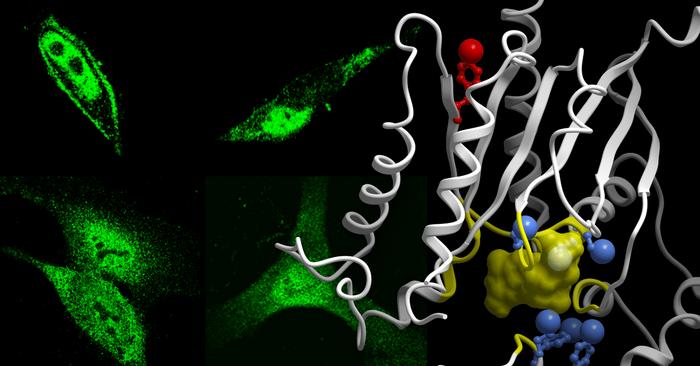Unraveling the origins of diseases by investigating cellular 'short circuits'

June 4, 2024
The quality of this article has been verified according to the editorial guidelines and policies of Science X. Editors scrutinized the content ensuring its credibility by highlighting the following attributes:
- Fact-checked
- Assessed by peer-reviewed publications
- Trusted sources
- Proofread
Validated by the University of California - San Diego
The focus of this article lies on research conducted by the University of California San Diego that traced back the origin of a 'short-circuit' in cellular pathways. They believe that this discovery could help in understanding the formation of various human diseases.
The said research has been published in Science Signaling, a scientific journal. It delves into the biochemical way that can disrupt cellular communication, which Pradipta Ghosh, M.D., compares to a catastrophic 'buzzer' putting an end to a game.
The principal authors of this paper are Ghosh, who works as a professor in the Departments of Medicine and Cellular and Molecular Medicine at the University of California San Diego School of Medicine, and Irina Kufareva, Ph.D., an associate professor at the Skaggs School of Pharmacy and Pharmaceutical Sciences of the same university.
This research explains the 'cross talk' between two cellular pathways— the first one is initiated by proteins known as growth factors, and the second one by their cellular receptors. Following these, a totally different set of G protein-coupled cellular receptors (GPCRs) mediates the second pathway. Both types of receptors send molecular signals from the outer to the inner part of the cell, prompting cellular changes. Kufareva informed that around 34% of all medicines approved by the U.S. Food and Drug Administration target GPCR family members.
'GPCRs are significant drug targets due to their role in signaling pathways linked to various diseases,' Kufareva mentioned, referring to illnesses like mental and endocrinological disorders, viral infections, cardiovascular and inflammatory conditions, and even cancer.
Growth factors initiate another crucial communication pathway inside cells that promote cell growth and division. While GPCRs act through intracellular molecular switches (G proteins), growth factor receptors conventionally bypass these switches. However, Ghosh and Kufareva noted that there had been suspicions regarding a potential conflict between the two pathways. The UC San Diego researchers' meticulous work has led to its identification.
According to Ghosh, the conflict occurs due to problematic phosphorylation, which attaches a phosphate group to the G protein molecule. She explained how the team utilized advanced mass spectrometry techniques to map the sites on G proteins where phosphorylated incidences called phosphoevents occurred when cells were stimulated by growth factors. Then they analyzed how this changes the capacity of G proteins to perform their usual job downstream of GPCRs.
Kufareva said, 'Whatever aspect of GPCR signaling we examined was adversely affected by almost all phosphoevents on the 'switch' protein—the G protein introduced by growth factors.' She then explained that this occurrence is understandable while considering how these phosphoevents deform the G protein structure. She further added that growth factors essentially 'steal' G proteins from GPCRs, thereby paralyzing their signaling.
Additional analyses revealed that a single amino acid was responsible for the appropriation of the G protein. Ghosh stated that this amino acid, known as tyrosine, is positioned at location 320 on the G protein. This spot also happens to be the area where the G protein makes contact with G protein-coupled receptors.
'This very tyrosine was identified nearly a decade ago as a special 'trigger point' for G protein-coupled receptors to pass on their signals. The significance of such a coincidence started to dawn on us,' Ghosh explained. 'We realized that if cell communication were likened to a game, the tyrosine at position 320 on the G protein would serve as the buzzer. If the growth factors reached it first and phosphorylated that site, then the G protein-coupled receptors hardly stood a chance.'
The group's revelation has potential implications for the creation of new therapies for a variety of conditions, including cancer. Ghosh mentioned that numerous pharmaceuticals in the market successfully help to treat a wide array of diseases because they target G protein-coupled receptors. However, the vital interaction of these two pathways remained undiscovered until now, leaving several conditions like fibrosis, chronic inflammation, and cancers without effective drug therapies.
'We believe our findings will be important and timely, enhancing other emerging studies mapping the landscape of these two major signaling pathways that control practically each and every process in our cells,' Ghosh concluded.
'Our work is especially relevant in that growth factors, their receptors, and G-protein-coupled receptors appear to be highly co-expressed in many cancers,' added Kufareva.
All authors on the paper are associated with UC San Diego. Suchismita Roy, Saptarshi Sinha and Ananta James Silas are members of the School of Medicine's Department of Cellular and Molecular Medicine, while Majid Ghassemian is a member of the Department of Chemistry and Biochemistry, Biomolecular and Proteomics Mass Spectrometry Facility.
Journal information: Science Signaling
Provided by University of California - San Diego




